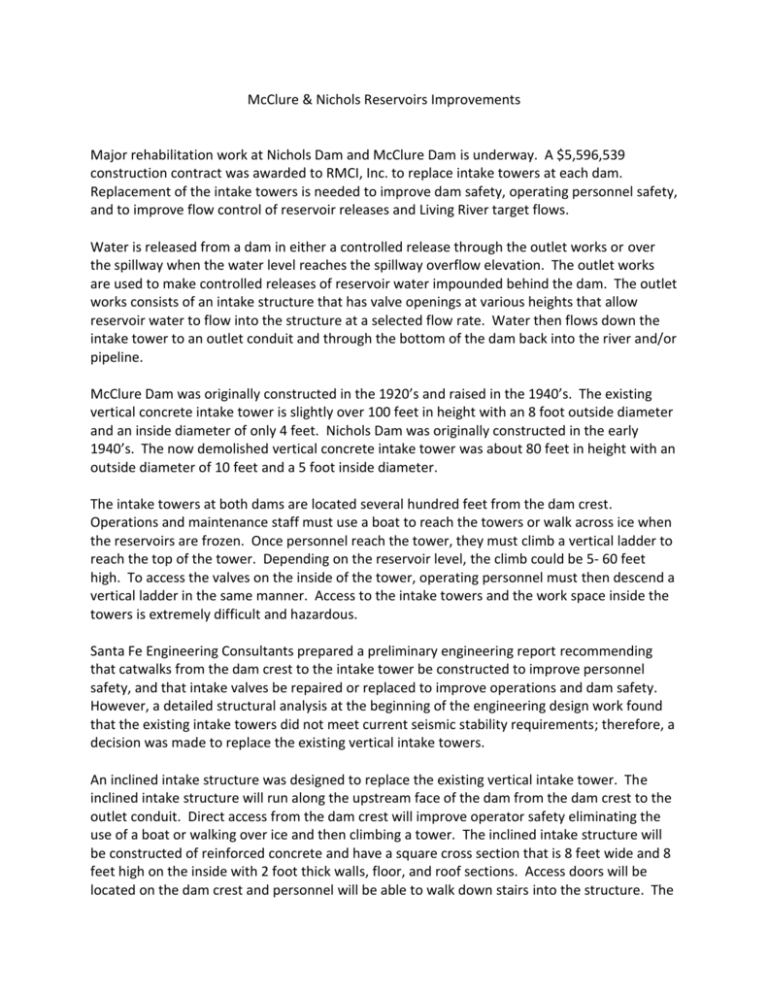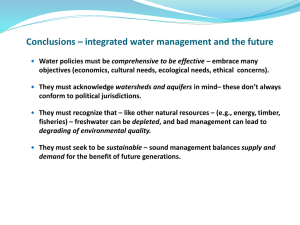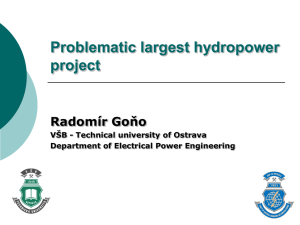Project Description and Photos
advertisement

McClure & Nichols Reservoirs Improvements Major rehabilitation work at Nichols Dam and McClure Dam is underway. A $5,596,539 construction contract was awarded to RMCI, Inc. to replace intake towers at each dam. Replacement of the intake towers is needed to improve dam safety, operating personnel safety, and to improve flow control of reservoir releases and Living River target flows. Water is released from a dam in either a controlled release through the outlet works or over the spillway when the water level reaches the spillway overflow elevation. The outlet works are used to make controlled releases of reservoir water impounded behind the dam. The outlet works consists of an intake structure that has valve openings at various heights that allow reservoir water to flow into the structure at a selected flow rate. Water then flows down the intake tower to an outlet conduit and through the bottom of the dam back into the river and/or pipeline. McClure Dam was originally constructed in the 1920’s and raised in the 1940’s. The existing vertical concrete intake tower is slightly over 100 feet in height with an 8 foot outside diameter and an inside diameter of only 4 feet. Nichols Dam was originally constructed in the early 1940’s. The now demolished vertical concrete intake tower was about 80 feet in height with an outside diameter of 10 feet and a 5 foot inside diameter. The intake towers at both dams are located several hundred feet from the dam crest. Operations and maintenance staff must use a boat to reach the towers or walk across ice when the reservoirs are frozen. Once personnel reach the tower, they must climb a vertical ladder to reach the top of the tower. Depending on the reservoir level, the climb could be 5- 60 feet high. To access the valves on the inside of the tower, operating personnel must then descend a vertical ladder in the same manner. Access to the intake towers and the work space inside the towers is extremely difficult and hazardous. Santa Fe Engineering Consultants prepared a preliminary engineering report recommending that catwalks from the dam crest to the intake tower be constructed to improve personnel safety, and that intake valves be repaired or replaced to improve operations and dam safety. However, a detailed structural analysis at the beginning of the engineering design work found that the existing intake towers did not meet current seismic stability requirements; therefore, a decision was made to replace the existing vertical intake towers. An inclined intake structure was designed to replace the existing vertical intake tower. The inclined intake structure will run along the upstream face of the dam from the dam crest to the outlet conduit. Direct access from the dam crest will improve operator safety eliminating the use of a boat or walking over ice and then climbing a tower. The inclined intake structure will be constructed of reinforced concrete and have a square cross section that is 8 feet wide and 8 feet high on the inside with 2 foot thick walls, floor, and roof sections. Access doors will be located on the dam crest and personnel will be able to walk down stairs into the structure. The inclined intake structure will have sufficient space for maintenance of piping, valves, and meters which will be located inside the structure. Reservoir water will be carried in the piping inside the concrete intake tunnel so the tunnel will be dry. The release of water through the reservoirs will be precisely controlled by automatically controlled valves with metered flow. Dam safety will be increased with the installation of intake valving and a redundant emergency drain valve system, which can be controlled from either the dam crest or remotely at the Canyon Road Water Treatment Plant and with improved dam instrumentation. Construction of the inclined intake structure requires that the reservoirs be drained, so work will be done on one reservoir per year. Work at Nichols Dam began September 3, 2013 and is currently on schedule to be substantially completed in mid-May 2014. Construction for McClure Dam is scheduled to begin September 1, 2014 and be substantially completed by June 8, 2015. The construction schedule was developed to minimize the adverse impacts on reservoir storage. Taking a reservoir out of service beginning in September allows reservoir water to be utilized during peak demand in the summer months. The refilling of the reservoir starting in late spring allows efficient capture of late spring runoff from the Santa Fe River. Work at Nichols Reservoir will be sufficiently completed by mid-May 2014 so that refilling the reservoir can begin. The draining of McClure Reservoir is now underway so that it will be drained to the elevation of the lowest intake valve by September 1, 2014; thereafter, RMCI can begin demolition and subsequent construction work. A reservoir management plan has been developed to accommodate the work at Nichols Reservoir and at McClure Reservoir. The water drained from McClure Reservoir will be treated and delivered to consumers. Also, any released water not treated will accommodate target flows under the Santa Fe ‘living river’ program, supply acequias, and fill Nichols Reservoir once construction is completed. The plan maximizes the use of water for treatment and delivery to water customers and minimizes excess release down the Santa Fe River. The reservoir management plan will undergo periodic review and adjustment based on watershed runoff projections, weather conditions, precipitation, and the availability of other water supply sources such as the Buckman Direct Diversion Project, Buckman Well Field, and water customers’ demand. Nichols Reservoir & Intake Tower Prior to Construction Nichols Reservoir Drained to Lowest Valve September 18, 2013 Nichols Dam Stop Log Removed September 25, 2013. Nichols Dam Showing Tower Demolition. Note: Santa Fe River Streamflow Feeding the Canyon Road Water Treatment Plant Nichols Dam Inclined Intake Structure Concrete Construction Nichols Dam Inclined Intake Structure Entrance McClure Dam and Reservoir on October 3, 2013. The Reservoir was at 86% of Total Storage Capacity After Heavy, Late Summer/Early Fall Rains






